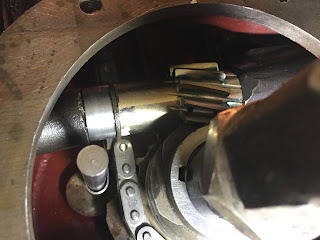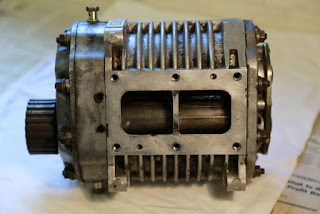Explore and discover the art within the mechanism. Each day we work with these creations and never stop appreciating their beauty! CONTACT: artinengineeringco@gmail.com
Wolseley cont'd and Christmas spirit..... click here to open.
Making ready to run the engine, oil pressure tested and supercharger belts on to enable a proper check of the pulleys for the first time. The build stand restricted the access to the engine front pulley before and so we were unable to do a final test fit and align faces. Now we are ready to assemble the front cover complete with the front engine mount.
Here we are modifying the frame to now properly locate the front of the engine via the front mounting. As is often the case with very "clean" sided cast engine blocks of the period, there are very few places to mount a conventional build stand.
Last month, we had carried out a very temporary overview by cranking the engine over with the pulleys attached. But, this was with limited engine support only allowing a limited amount of trial pulley alignment and to check the operation of my new oversize dynamo pulley. It also gave us an opportunity to prepare a special woodruff key to overcome the fact that during nitride treatment, the keyway in the crankshaft had closed by several thousandths of an inch along with the flywheel bolt location holes in the rear crank flange (see previous posts re these issues). Here we are just giving a final dress to our previously made "stepped" key before fitting to the front engine pulley and crank.
Of course even on this home stretch, there are always small problems. The carburettor piston had a very dull piston closure sound when lifted and dropped as if the needle was catching the jet. Thinking it would be a simple case of releasing and centralising the jet block, I was a little unsure why the block seemed to bind (from experience they normally slide into position very easily). Removal of the jet block revealed the problem; the two small soft jet glands sit in small brass cupped washers onto which the pressure spring bears. Except, on this unit the washers were missing and the soft glands were distorted and bound up inside the spring, stopping any form of side adjustment. Not wanting to delay even further, luckily we had another SU on the back of the bench enabling me to "borrow" the washer as well as borrow a replacement fibre vent washer for the top nut of the float chamber as this washer was also missing.Whilst in this area, I had made a new banjo for the fuel feed, the unit is quite large and bulky for this application which has limited room. By making a slimmer unit of a slightly altered shape, we have quite a nice arrangement. But.....(there is always a but when you change a design!) I hadn't quite made it deep enough by about 010" resulting in a fuel weep. To correct this I machined an extra thick aluminium washer to suit. I will make some spares of these non std washers for the car's toolbox.
Wolseley Hornet finishing attention... please click here to open
We have machined a temporary nylon arrangement for simple oil filtration ready for this very brief engine first run as we do not have the original gauze. However, provision will be made to have a discrete modern oil filter within the housing before the next run.
Wolseley Hornet engine finish build and pre run preparation .... please click here to open
It is a busy November here. As well as trying to get the Standard Vanguard (further post to follow) up together before Christmas, we are currently altering the Wolseley workshop engine stand to allow us to briefly run the engine in the workshop. This is to strengthen the supports as well as give me access to fit the front pulley, something I had overlooked when I made the wooden stand! The engine will the be run very briefly to check oil pressure and operation but avoiding prolonged off load running to avoid glazing the bores.
The nature of this, largely one off work, is always very time consuming, even to the end. I 've been caught out with a clearance problem on the inlet manifold and some casting issues internally. Despite being test fitted I had not foreseen this problem as the oil return pipe was not fitted until now. Rather than strip totally, you can see that I have wrapped and sealed the whole thing in a bag and then carefully hacksawed, chiselled and filed the new corner shape. We also noted a casting flaw that would allow air leakage, but that is remedied with a sealing washer beneath a bolt.
Finally, the supercharger has been bolted on, carefully monitoring the free operation of the rotors in case the tightening of the unit causes any distortion. On this point, we have also noted distortion in the carburettor manifold flange (something I had previously missed). As I tightened this to the supercharger I could easily move a 0.005" feeler gauge in an area of the joint without any nip. It is important to be careful here as any form of twist can risk distorting the supercharger housing and upset the very precise internal clearances. We will have to carefully hand face this flange and refit.
As an extra check, I have measured the supercharger rotation torque on the bench with a spring balance and measured lever point, I can use this as a datum when looking for any case of distortion and clearance changes within the housing when fitting. This can also be carried between engine test runs.
With the unit in position we have carried out further rotation tests up to 3000rpm with a battery gun.
Final Volumex Conversion Drawings
The following is prototype only, and has not yet been proven.
Shown below are the final versions of the Volumex adaptor set.
3D CAD Drawings of Volumex Adaptor Kit for Wolseley...(Click to Open)
Continuing on from our previous post. Through the 3D printed prototypes, we can see our design's accurate fitting and function. We required some minor modifications, considerably easier on a 3D printed object than that of a final machined or cast item.
As a result the drawings can now be prepared and presented into documentation that can easily be understood and shared via email and paper form to any future parties. Shown below are screenshots of the final illustrations, visualising dimensions required for fabrication and any other necessary notes.
We just have do carry out a little more study of the drive shaft and housing, these will be completed and posted shortly.
J
Volumex Supercharger adaptor prototype. ....please click here to open.
Continued from previous post. Here we have some further conceptual adaptor design work to allow the option of a Volumex supercharger fitted on to the Wolseley Supercharge inlet manifold and belt drive coupling and shaft arrangement.
Lots of Supercharger work in the second half of this year...
Earlier this year and a little through last year, you will see posts of the previous supercharger modifications to adapt to the Wolseley Hor...




























































